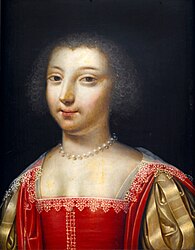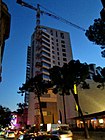File:Ducayer - Portrait of a Lady, Uncertainly Identified as Anne de Bretagne, or her sister, Marie d’Avagour.jpg

Original file (503 × 644 pixels, file size: 243 KB, MIME type: image/jpeg)
Captions
Captions
Summary
edit| Jean Ducayer: Portrait of a Lady, Uncertainly Identified as Anne de Bretagne, Demoiselle de Goëllo (c. 1620/25-1707), or her Elder Sister, Marie d’Avagour de Bretagne, Duchesse de Montbazon (1611/12-1657)
|
|||||||||||||||||||||
|---|---|---|---|---|---|---|---|---|---|---|---|---|---|---|---|---|---|---|---|---|---|
| Artist |
|
||||||||||||||||||||
| Title |
Portrait of a Lady, Uncertainly Identified as Anne de Bretagne, Demoiselle de Goëllo (c. 1620/25-1707), or her Elder Sister, Marie d’Avagour de Bretagne, Duchesse de Montbazon (1611/12-1657) label QS:Len,"Portrait of a Lady, Uncertainly Identified as Anne de Bretagne, Demoiselle de Goëllo (c. 1620/25-1707), or her Elder Sister, Marie d’Avagour de Bretagne, Duchesse de Montbazon (1611/12-1657)" |
||||||||||||||||||||
| Object type |
painting |
||||||||||||||||||||
| Genre |
portrait |
||||||||||||||||||||
| Description |
English: Presumed portrait of Marie de Bretagne d'Avaugour (1610-1657), wife of Hercule de Rohan, Duke of Montbazon, or her sister Anne.
|
||||||||||||||||||||
| Date |
between 1620 and 1640 date QS:P,+1650-00-00T00:00:00Z/7,P1319,+1620-00-00T00:00:00Z/9,P1326,+1640-00-00T00:00:00Z/9 |
||||||||||||||||||||
| Medium |
oil on panel |
||||||||||||||||||||
| Dimensions |
height: 35 cm (13.7 in) dimensions QS:P2048,+35U174728 dimensions QS:P2049,+27U174728 |
||||||||||||||||||||
| Collection |
|
||||||||||||||||||||
| References |
https://www.leventisgallery.org/explore-the-aglc/collections/the-paris-collection/painting/45 |
||||||||||||||||||||
| Source/Photographer | https://smartify.org/fr/artworks | ||||||||||||||||||||
Licensing
edit|
This is a faithful photographic reproduction of a two-dimensional, public domain work of art. The work of art itself is in the public domain for the following reason:
The official position taken by the Wikimedia Foundation is that "faithful reproductions of two-dimensional public domain works of art are public domain".
This photographic reproduction is therefore also considered to be in the public domain in the United States. In other jurisdictions, re-use of this content may be restricted; see Reuse of PD-Art photographs for details. | |||||
File history
Click on a date/time to view the file as it appeared at that time.
| Date/Time | Thumbnail | Dimensions | User | Comment | |
|---|---|---|---|---|---|
| current | 06:44, 19 January 2022 |  | 503 × 644 (243 KB) | Ecummenic (talk | contribs) | {{Artwork |artist ={{Creator:Jean Ducayer}} |title = |description="Portrait of a Lady, Uncertainly Identified as Anne de Bretagne, Demoiselle de Goëllo (c. 1620/25-1707), or her Elder Sister, Marie d’Avagour de Bretagne, Duchesse de Montbazon (1611/12-1657) The face of the woman in this picture bears little resemblance to that in a painting by the same, or a very similar, hand in the Musée du Château de Versailles that is also called Marie de Bretagne, Duchesse de Montbazon,(1) and... |
You cannot overwrite this file.
File usage on Commons
The following page uses this file:
File usage on other wikis
The following other wikis use this file:
- Usage on fr.wikipedia.org
- Usage on www.wikidata.org
Metadata
This file contains additional information such as Exif metadata which may have been added by the digital camera, scanner, or software program used to create or digitize it. If the file has been modified from its original state, some details such as the timestamp may not fully reflect those of the original file. The timestamp is only as accurate as the clock in the camera, and it may be completely wrong.
| Orientation | Normal |
|---|---|
| Horizontal resolution | 72 dpi |
| Vertical resolution | 72 dpi |
| Software used | Adobe Photoshop CC 2017 (Windows) |
| File change date and time | 01:40, 19 January 2022 |
| Color space | Uncalibrated |
| Date and time of digitizing | 20:40, 18 January 2022 |
| Date metadata was last modified | 20:40, 18 January 2022 |
| Unique ID of original document | xmp.did:a2236faa-5b45-1545-ac99-7057f7009223 |

